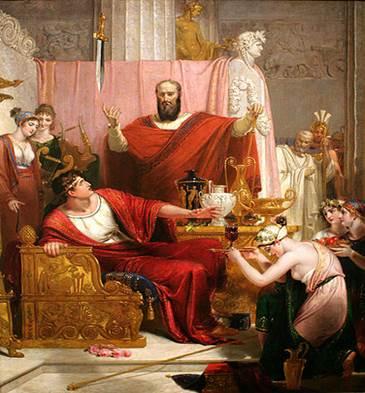Damocles in Detroit: Union Sword about to Drop

The United Auto Workers is getting set for contract negotiations for General Motors, Ford, and Fiat Chrysler for the 140,000 automotive workers the union represents. The current agreements are due to expire on September 14th of this year.
This comes at a time when the five-year ban on striking-imposed as condition of receiving bailout money- at GM and Fiat Chrysler has expired, opening up Detroit to the potential of a strike. The UAW has not led a strike on any of the Big Three automotive companies since 2007, and not for an extended period since 1990.
1n 2009, the government bailed out GM and Fiat Chrysler at the height of the financial crisis requiring the companies to declare bankruptcy as a condition of receiving the taxpayer billions. The union was forced to make small concessions during the downturn.
Those UAW concessions included the union hated multi-tier pay system. In the multi-tier system, current employees at the time of the bankruptcy were allowed to continue being paid at the level they had been, but newer employees were paid less to keep the labor costs more reasonable and competitive.
The no-strike policy, restrictions on over-time, scrapping the job bank, and no raise for the workers were a part of the concessions made.
Thanks in part to the concessions, the automotive industry is coming alive after the bankruptcies and finally earning a profit instead of accumulating more debt. Combined, the three car manufacturing giants have earned $73 billion in operating profit since the last UAW contract was ironed out. Over 17 million vehicles are expected to be sold on the U.S. market this year, a new record. But how long will good times continue to roll off the assembly line?
According to many industry players this automotive economic boom time is shaky at best, and unlikely continue for any time of great length. Gas prices will fluctuate and likely increase, loan rates won’t always be this low, and insurance premiums are on track to become even more of a burden to consumers. Bernie Woodall and Ben Klayman of Reuters predicted in a June 2nd, 2015 article that, “the [auto] recovery could have limits,” and that younger, millennial consumers were delaying getting their licenses and making car purchases. All of these factors add up to the conclusion that the auto market will continue to be temperamental and today’s trends may not last.
Additionally, unionized workers were never shut out of the profits Motor City’s Big Three have been slowly accumulating. For the past four years, union members were paid bonuses by the auto manufacturers averaging out to $7,500 a year.
But now that the current agreements are due to expire in short couple months’ time the UAW once again has its hand out. The union feels that the Big Three owes workers even more, and is demanding the end of the multi-tier system that helped save the U.S. auto industry. They want all workers to be paid at the same unsupportable levels, and even get a raise on top of that. The UAW may not think that cars grow on trees, but they sure must think money does.
The Wall Street Journal reported in December of 2014 that, United Auto Workers President Dennis Williams said, “the current two-tier wage scale for auto workers is unacceptable, and the roughly $19.50 an hour wage new hires earn should be a ‘good starting point’ for negotiations with Detroit auto makers.”
Of course, these are the types of demands that bankrupted the companies in the place.
The automotive giants had been seeing the numbers stacking against them for years, but of the three only Ford did anything to stop from going off the cliff. Combating incredible debts, unsupportable labor costs, too many dealers, and quality control issues, Ford made tough decision before the financial crisis to check the runaway costs; GM and Chrysler did nothing. Ford restructured the company and as a result did not require the taxpayer bailout money.
GM and Chrysler did need that money, and the Bush Administration loaned the companies funds from the Troubled Asset Relief Program (TARP). Then when that money was not enough to solve the humungous cash flow problem, the auto company executives came to Washington to ask for more money. This time President Obama forced the automakers into declaring bankruptcy as a means to force restructuring. The new “General Motors” and “Chrysler” were now partially subsidized and owned by the U.S. government.
This is where it began to get especially costly for Americans due to the UAW getting more than its fair share. The Treasury Department originally loaned the money to the struggling automotive manufacturers with the intention of getting paid back in full. That did not happen though, not even close. The total taxpayer loss was over $30 billion.
Many people think this bailout saved thousands of American jobs, and a potential market crash that could have rivaled the Great Depression. But this gargantuan debt taken out by taxpayers was avoidable. James Sherk, a Senior Policy Analyst in Labor Economics at the Heritage Foundation testified to that effect before the Committee on Oversight and Government Reform for the House on June 10th, 2013.
Sherk states in his testimony that, “the entirety of these losses occurred because the administration gave the United Auto Workers (UAW) special treatment.” Sherk also testified that:
“The UAW recovered far more in the bankruptcy than it had a legal right to:
· Legally, the UAW’s claims had the same status as those of other unsecured creditors, but the UAW recovered a much greater proportion of the debts that General Motors and Chrysler owed the union.
· Bankruptcy typically brings uncompetitive wages down to competitive levels. However, existing UAW members did not take pay cuts at General Motors.
· The restructured General Motors used taxpayer funds to “top up” the pensions of unionized retirees at Delphi, its bankrupt former parts subsidiary. New GM had no legal obligation to do so and nonunion employees did not receive similar benefits.”
It is no wonder that Sherk references the auto bailout as the UAW bailout.
But, why would the UAW not want to ask for more money, more benefits, and less responsibility from the Big Three when it worked out so clearly in their favor thanks to the Obama administration’s handling of the crisis? The government taught the UAW that it’s okay to bleed an industry dry because Uncle Sam and the taxpayer will be around to clean up and make sure its members still have jobs.
There is an old story called the Sword of Damocles. It is about a man named Damocles who wanted to be king. When he ascended the throne he saw a sword dangling above him, a gift left to him by his predecessor, a reminder about ruling. You can never be comfortable while you are on top.
The Big Three want to be on top again, but the more profitable they become the closer the sword gets. If they want a more peaceful rule this time around, they need to eliminate the sword.





